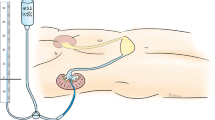Abstract
We evaluated the long-term effects of percutaneous nephrolithotomy (PNL) on renal morphology and vascular resistance. Parenchyma thickness, echogenicity and resistive index (RI) of upper, middle and lower poles of operated and contralateral kidneys of 41 patients with 82 renal units who underwent unilateral PNL with single pole access between 2000 and 2002 were examined separately by color Doppler ultrasonography. Mean patient age and duration between PNL and evaluation time were 38.29±11.53 years and 46.44±10.9 months, respectively. In operated kidney, mean RI, parenchyma thickness and echogenicity of the access pole were not statistically different than those of the adjacent two poles (0.608±0.053 vs. 0.608±0.052 for RI, P=0.895; 11.46±2.58 vs. 11.41±2.68 mm for parenchyma thickness, P=0.838; 0.049±0.31 vs. 0.073±0.33 for parenchyma echogenicity, P=0.160, respectively). Although mean RI and parenchyma thickness of access pole were statistically significantly different than the mean values of contralateral kidney (0.562±0.032 and 14.31±1.37 mm, respectively), no statistical difference was found between mean parenchyma echogenicities of both of them (echogenicity of contralateral kidney was 0, P=0.317). No significant difference was found between the average echogenicities of the three poles of the operated and contralateral kidneys (0.063±0.32 vs. 0, P=0.080). In 14 patients RI decreased from 0.694±0.058 to 0.602±0.056 in operated kidney (P=0.001) and from 0.604±0.06 to 0.559±0.031 in contralateral kidney (P=0.018) following PNL. It seems that PNL does not cause renal scarring, renal parenchymal loss or increase in renal vascular resistance in the long term. However, prospective studies must be performed for more definitive conclusions.
Similar content being viewed by others
References
Menon M, Parulkar BG, Drach GW (1998) Urinary lithiasis: etiology, diagnosis and medical management. In Walsh PC, Retik AB, Vaughan ED Jr, Wein AJ (eds) Campbell’s urology, 7th edn, vol 3, chap 91. W.B. Saunders, Philadelphia, pp 2661–2733
Sutherland J, Parks J, Coe F (1985) Recurrence after a single renal stone in a community practice. Miner Electrolyte Metab 11:267–269
Şahin A, Tekgül S, Erdem E et al (2000) Percutaneous nephrolithotomy in older children. J Pediatr Surg 35:1336–1338
Fernstrom I, Johansson B (1976) Percutaneous pyelolithotomy: a new extraction technique. Scand J Urol Nephrol 10:257–259
Chatham JR, Dykes TE, Kennon WG et al (2002) Effect of percutaneous nephrolithotomy on differential renal function as measured by mercaptoacetyl triglycine nuclear renography. Urology 59:522–525
Papanicolaou N (1998) Urinary tract imaging and intervention: basic principles. In: Walsh PC, Retik AB, Vaughan ED Jr, Wein AJ (eds) Campbell’s urology, 7th edn, vol 1, chap 6. W.B. Saunders, Philadelphia, pp 170–260
Moghazi S, Jones E, Schroepple J, Arya K, McClellan W, Hennigar RA, O’Neill C (2005) Correlation of renal histopathology with sonographic findings. Kidney Int 67:1515
Özçelik G, Polat TB, Aktaş S, Çetinkaya F (2004) Resistive index in febrile urinary tract infections: predictive value of renal outcome. Pediatr Nephrol 19(2):148–152
Shokeir AA, Nijman RJM, El-Azab M et al (1996) Partial ureteric obstruction: a study of Doppler ultrasonography and diuretic renography in different grades and durations of obstruction. Br J Urol 78:829–835
Rawashdeh YF, Djurhuus JC, Mortensen J et al (2001) The intrarenal resistive index as a pathophysiological marker of obstructive uropathy. J Urol 165:1397–1404
Mostbeck GH, Gossinger HD, Mallek R et al (1990) Effect of heart rate on Doppler measurements of resistive index in renal arteries. Radiology 175:511–513
Kublickas M, Randmaa I, Lunell NO et al (1993) Effect of variations of heart rate within the normal range on renal artery Doppler indices in nonpregnant and pregnant women. J Clin Ultrasound 21:507–510
Trovato GM, Catalano D, Sciacchitano G et al (2002) Resistive index of renal artery and blood pressure in postmenopausal women. Maturitas 41:223–230
Rushton HG, Majd M (1992) Dimercaptosuccinic acid renal scintigraphy for the evaluation of pyelonephritis and scarring: a review of experimental and clinical studies. J Urol 148:1726–1732
Smellie JM, Shaw PJ, Prescod NP, Bantock HM (1988) 99mTc dimercaptosuccinic acid (DMSA) scan in patients with established radiological renal scarring. Arch Dis Child 63:1315–1319
Halevy R, Smolkin V, Bykov S, Chervinsky L, Sakran W, Koren A (2004) Power Doppler ultrasonography in the diagnosis of acute childhood pyelonephritis. Pediatr Nephrol 19:987–991
Desai MR, Kukreja RA, Patel SH et al (2004) Percutaneous nephrolithotomy for complex pediatric renal calculus disease. J Endourol 18:23–27
Mor Y, Elmasry YE, Kellet MJ (1997) The role of percutaneous nephrolithotomy in the management of pediatric renal calculi. J Urol 158:1319–1321
Lechevallier E, Siles S, Ortega JC et al (1993) Comparison by SPECT of renal scars after extracorporeal shock wave lithotripsy and percutaneous nephrolithotomy. J Endourol 7:465–467
Traxer O, Smith TG 3rd, Pearle MS et al (2001) Renal parenchymal injury after standard and mini percutaneous nephrostolithotomy. J Urol 165:1693–1695
Arima M, Ishibashi M, Usami M et al (1979) Analysis of the arterial blood flow patterns of normal and allografted kidneys by the directional ultrasonic Doppler technique. J Urol 122:587–591
Aoki Y, Ishitoya S, Okubo K et al (1999) Changes in resistive index following extracorporeal shock wave lithotripsy. Int J Urol 6:483–492
Kilic S, Altinok MT, Ipek D et al (2005) Color Doppler sonography examination of partially obstructed kidneys associated with ureteropelvic junction stone before and after percutaneous nephrolithotripsy: preliminary report. Int J Urol 12:429–435
Webb DR, Fitzpatrick JM (1985) Percutaneous nephrolithotripsy: a functional and morphological study. J Urol 134:587–591
Author information
Authors and Affiliations
Corresponding author
Rights and permissions
About this article
Cite this article
Kiliç, S., Altinok, T., Altunoluk, B. et al. Long-term effects of percutaneous nephrolithotomy on renal morphology and arterial vascular resistance as evaluated by color Doppler ultrasonography: preliminary report. Urol Res 34, 178–183 (2006). https://doi.org/10.1007/s00240-006-0038-4
Received:
Accepted:
Published:
Issue Date:
DOI: https://doi.org/10.1007/s00240-006-0038-4



